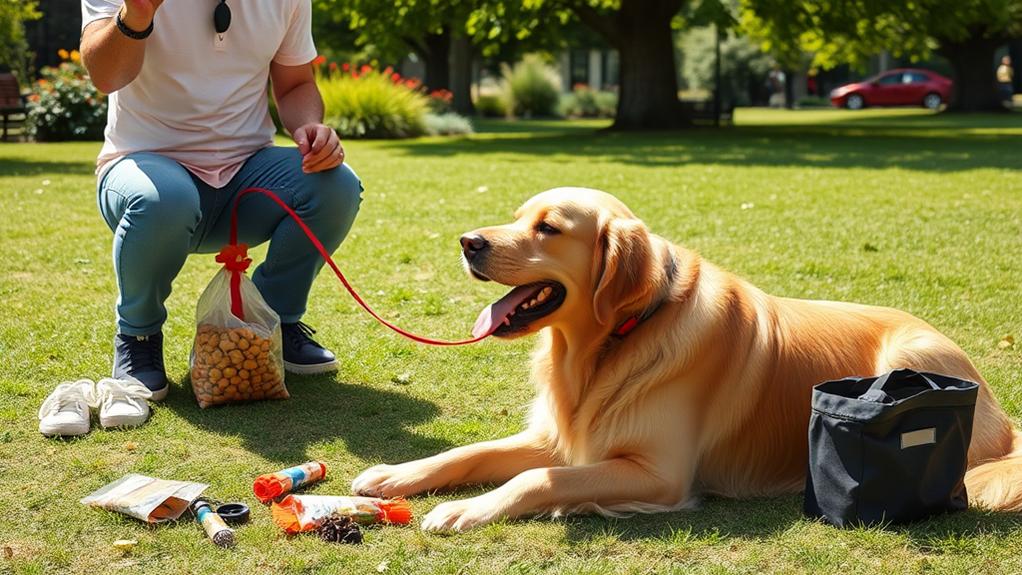You can become your dog's teacher with a step-by-step training guide designed just for you. Start by understanding your dog's behavior—observe their body language and vocalizations. Equip yourself with essential training tools like a sturdy leash, high-value treats, and a clicker. Begin training with basic commands such as sit, stay, and come. Use positive reinforcement to motivate your dog while ensuring a calm, distraction-free environment. As you build a solid foundation, you can progress to advanced tricks and techniques. Keep practicing and nurturing your bond, and you'll uncover even more strategies to enhance your dog's training journey.
Understanding Your Dog's Behavior
Understanding your dog's behavior is essential for effective training, especially since dogs communicate primarily through body language and vocalizations. By observing your dog's posture, tail movements, and facial expressions, you can gain valuable insights into their emotional state. For instance, a wagging tail might indicate excitement or happiness, while a tucked tail often suggests fear or submission.
Pay attention to vocalizations too. Barking can express a range of feelings, from excitement to alertness, while whining may indicate anxiety or a desire for attention. Recognizing these cues helps you respond appropriately to your dog's needs.
Additionally, consider the context of your dog's behavior. Are they acting differently in new environments or around unfamiliar people? This awareness allows you to tailor your training approach to help your dog feel more comfortable and secure.
Building a strong bond with your dog starts with understanding them. When you respond to their behaviors with patience and empathy, you'll create a positive training atmosphere. Remember, effective communication lays the foundation for successful training, so take the time to learn what your dog's behavior is trying to tell you.
Essential Training Tools

To effectively communicate with your dog and reinforce training, having the right tools on hand can make a significant difference. Start with a sturdy leash and collar or harness. A 6-foot leash gives you control while allowing your dog some freedom to explore. Choose a collar or harness that fits comfortably, ensuring it won't cause any irritation.
Next, consider using treats as rewards. High-value treats can motivate your dog and help them associate positive experiences with training. Keep a variety of treats handy to maintain their interest. You might also want to have a clicker for clicker training. This tool helps you mark good behavior instantly, making it clear to your dog what they did right.
Additionally, having a designated training space can help your dog focus. This space should be free from distractions to create an ideal learning environment. Finally, invest in a training book or app for guidance and tips. With the right tools, you'll set yourself and your dog up for successful training sessions, making the learning process enjoyable for both of you. Remember, consistency and patience are key!
Basic Commands to Start With
Starting with basic commands lays the foundation for effective communication with your dog. These commands not only help establish rules but also create a stronger bond between you and your furry friend. Here are three essential commands to start with:
- Sit: This is a simple command that helps your dog understand the concept of waiting and being calm.
- Stay: Teaching your dog to stay in one spot can be important for safety and control in various situations.
- Come: This command is essential for ensuring your dog returns to you when called, which can prevent dangerous situations.
To begin training, use positive reinforcement, like treats or praise, whenever your dog successfully follows a command. Keep training sessions short and fun—around 5 to 10 minutes—to maintain your dog's interest. Consistency is key, so practice these commands daily. Remember to be patient; every dog learns at their own pace. With time and practice, these basic commands will become second nature for your dog, allowing for better communication and understanding as you continue your training journey together.
Advanced Tricks and Techniques

Once you've mastered the basics, it's time to step up your game with advanced tricks and techniques that can impress friends and enhance your dog's skills. Teaching your dog these advanced tricks not only showcases their intelligence but also strengthens your bond. Here are some popular tricks you can work on together:
| Trick | Description | Tips |
|---|---|---|
| Roll Over | Your dog lies down and rolls over. | Use treats and a hand signal. |
| Play Dead | Your dog falls over and stays still. | Start with "bang" as a cue. |
| Spin | Your dog turns in a circle. | Use treats to guide them. |
| Speak | Your dog barks on command. | Reward them for making noise. |
To start, break each trick down into small steps, using plenty of positive reinforcement. Patience is key, so don't rush it. Practice regularly, and keep sessions short and fun. Soon, you'll have a dog that not only knows the basics but can also perform impressive tricks that will leave everyone in awe!
Building a Positive Training Environment

Creating a positive training environment is key to successful learning for your dog. When you foster a space where your dog feels safe and encouraged, you'll see better results and a stronger bond. Here are some essential elements to ponder:
- Consistency: Use the same cues and commands each time to avoid confusing your dog.
- Rewards: Incorporate treats, praise, or playtime as positive reinforcement to motivate your dog.
- Patience: Understand that learning takes time; celebrate small victories along the way.
To build this environment, start by selecting a quiet space free from distractions. This helps your dog focus on you and the task at hand. Keep training sessions short and engaging, ideally around 5-10 minutes, to maintain your dog's interest. Always approach training with a calm demeanor; your energy influences your dog's mood. If your dog becomes frustrated or overwhelmed, take a break and try again later. Remember, training should be a fun experience for both of you. By emphasizing positivity and encouragement, you'll not only teach your dog effectively but also strengthen your bond and trust.
Conclusion
By now, you've learned how to understand your dog's behavior and the tools needed for effective training. Starting with basic commands paves the way for advanced tricks, making training both fun and rewarding. Remember, creating a positive environment is key to your dog's success. With patience and consistency, you'll not only teach your furry friend but also strengthen your bond. So grab those treats and start training—your dog's journey to becoming a well-behaved companion begins now!



